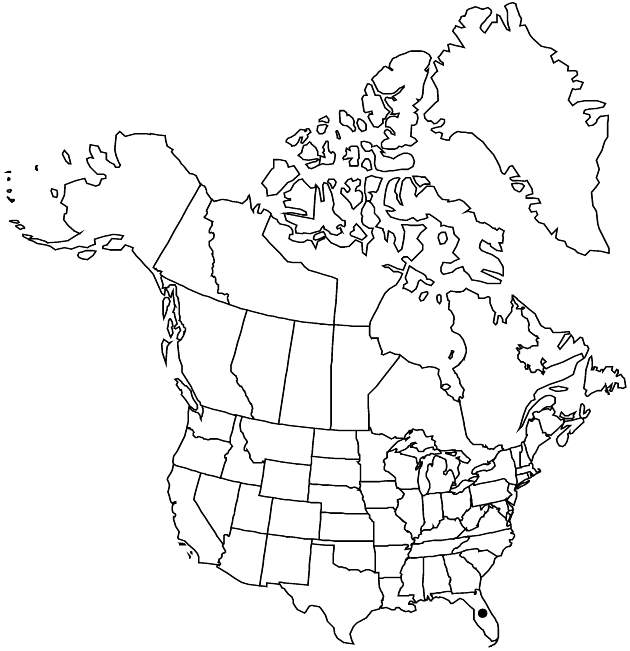Difference between revisions of "Chrysopsis floridana"
Fl. S.E. U.S., 1183, 1339. 1903.
FNA>Volume Importer |
FNA>Volume Importer |
||
| Line 12: | Line 12: | ||
|name=Chrysopsis mariana var. floridana | |name=Chrysopsis mariana var. floridana | ||
|authority=(Small) Fernald | |authority=(Small) Fernald | ||
| + | |rank=variety | ||
}} {{Treatment/ID/Synonym | }} {{Treatment/ID/Synonym | ||
|name=Heterotheca floridana | |name=Heterotheca floridana | ||
|authority=(Small) R. W. Long | |authority=(Small) R. W. Long | ||
| + | |rank=species | ||
}} {{Treatment/ID/Synonym | }} {{Treatment/ID/Synonym | ||
|name=Heterotheca mariana subsp. floridana | |name=Heterotheca mariana subsp. floridana | ||
|authority=(Small) V. L. Harms | |authority=(Small) V. L. Harms | ||
| + | |rank=subspecies | ||
}} | }} | ||
|hierarchy=Asteraceae;Asteraceae tribe Astereae;Chrysopsis;Chrysopsis floridana | |hierarchy=Asteraceae;Asteraceae tribe Astereae;Chrysopsis;Chrysopsis floridana | ||
| Line 43: | Line 46: | ||
-->{{#Taxon: | -->{{#Taxon: | ||
name=Chrysopsis floridana | name=Chrysopsis floridana | ||
| − | |||
|authority=Small | |authority=Small | ||
|rank=species | |rank=species | ||
| Line 58: | Line 60: | ||
|publication year=1903 | |publication year=1903 | ||
|special status= | |special status= | ||
| − | |source xml=https://jpend@bitbucket.org/aafc-mbb/fna-data-curation.git/src/ | + | |source xml=https://jpend@bitbucket.org/aafc-mbb/fna-data-curation.git/src/eaa6e58056e40c9ef614d8f47aea294977a1a5e9/coarse_grained_fna_xml/V19-20-21/V20_476.xml |
|tribe=Asteraceae tribe Astereae | |tribe=Asteraceae tribe Astereae | ||
|genus=Chrysopsis | |genus=Chrysopsis | ||
Revision as of 19:28, 16 December 2019
Perennials or subshrubs, 30–70 cm; fibrous-rooted or rhizomatous (new rosettes from bases of old shoots, additional rosettes at ends of short lateral rhizomes or roots). Stems erect or ascending, sometimes branched, densely short-woolly. Leaves: basal blades spatulate to oblanceolate, 40–100 × 15–25 mm, margins entire or apically dentate, faces densely short-woolly; cauline blades obovate to oblanceolate, gradually or hardly reduced distally, bases cuneate to slightly auriculate-clasping, margins entire, sometimes undulate, cilia rarely more than 1 mm, apices mucronulate, faces densely appressed-tomentose, sparsely stipitate-glandular (glands hidden by hair). Heads 1–25+ in subumbelliform to paniculiform arrays (proximal branches sometimes also flowering). Peduncles 1–4 cm, densely stipitate-glandular; bracteoles 0–4, lineaer to oblanceolate, proximally woolly, stipitate-glandular distally. Involucres (yellow-green in bud) campanulate, 5–8 mm. Phyllaries in 3–4 series, erect, linear, unequal, 0.6–1 mm wide, apices sharply acute or acuminate to aristate, faces stipitate-glandular. Ray florets 15–20; laminae 6–8 × 1.5–2.5 mm. Disc florets 25–35; corollas 6–7 mm, lobes 0.5 mm. Cypselae 2–2.5 mm, without ridges, smooth or faintly ribbed, moderately strigose; pappi in 3 series, outer of linear scales 0.5–1 mm, inner of 25–30 bristles 5–6 mm, inner weakly clavate. 2n = 10.
Phenology: Flowering mid to late fall.
Habitat: Sand pine–evergreen oak scrub, very well drained, fine, white sands
Elevation: 0–30 m
Discussion
Of conservation concern.
Chrysopsis floridana is found in Hardee, Hillsborough, Manatee, and Pinellas counties. It has been subject to habitat destruction at most historic sites. It is listed as endangered in the Federal Register and is in the Center for Plant Conservation’s National Collection of Endangered Plants.
Selected References
None.
